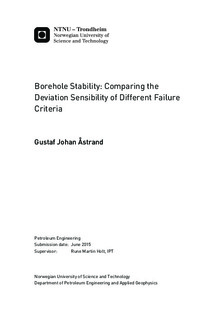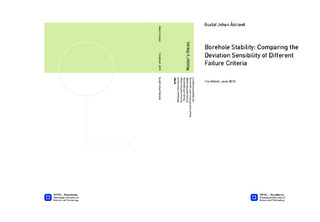| dc.description.abstract | During drilling the down-hole pressure has to be sufficient enough to prevent collapse of the wellbore, while at the same time it cannot exceed the fracture limit. Borehole failure can lead to a stuck pipe situation which is time consuming and costly. Ultimately it can evoke serious economic consequences due to the impending need of abandoning the well. Neither drilling with an unnecessary high wellbore pressure, where the margin between collapse and fracturing is sufficient, is economically viable since it will slow down the rate of penetration. Predicting the required mud weight to avoid collapse is a complex process where formation properties and conditions together with the orientation of the wellbore will affect the outcome.
By modeling the stresses around the wellbore and inserting them into a failure criterion a prediction of the required mud weight can be obtained. Several failure criteria is suggested in the literature. The objective of this thesis is to compare their sensibility to deviation as well as gaining a greater understanding of how to perform required mud weight predictions.
Four different failure criteria have been investigated through simulations performed in PSI. Four different cases were assumed and used as input for the simulations. In order to evaluate the Mogi-Coulomb failure criterion and gain knowledge of mud weight prediction calculations a Matlab program was written by the author. Inclination and azimuth sensibility analyzes were run to investigate the different failure criteria s response to deviation.
The Matlab program provides a user friendly output for all possible wellbore orientations and generates results that coincide with the theory and the PSI simulations. Further more the conducted sensibility analyses and failure criteria comparison reveal a wide disagreement between the different failure criteria regarding the minimum mud weight prediction. In case 1 the Mohr-Coulomb and Mogi-Coulomb failure criteria predict the direction of the minimum horizontal in situ stress to be the most beneficial with respect to avoiding collapse, whereas the Drucker-Prager and Stassi-D Alia failure criteria prefer the direction of the maximum horizontal stress. This emphasizes how crucial the choice of failure criteria is for predicting the correct minimum mud weight requirement. | |

